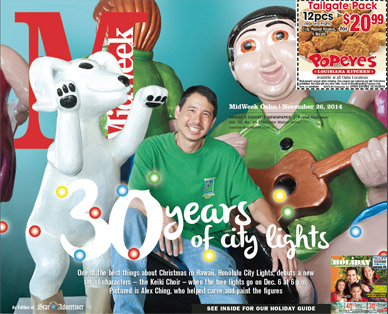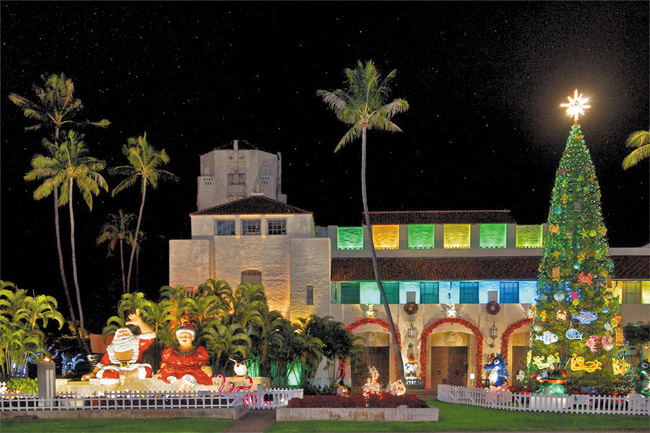30 Years Of City Lights
One of the best things about Christmas in Hawaii, Honolulu City Lights, debuts a new set of characters when the tree lights go on Dec. 6 at 6 p.m.
Decapitations. Gender swapping. Mythical giants taking up residence in the seat of power.
These are not the plot points of a new HBO series — this is what happens when you give a city Christmas for three straight decades.
The old adage about busting a few eggs to make breakfast applies to Honolulu City Lights (HCL) as well. Started by Frank Fasi in 1985 as a gift to the citizens of Hawaii, it has grown into an annual event that thousands attend and, for many residents of this island, it truly kicks off the holiday season.
But a party this large does not happen without a few pratfalls, like the year lady Frosty was beheaded.
“One year we were moving the snow family (from a warehouse in Pearl City),” says Sheri Kajiwara, the city coordinator for HCL, “and I don’t know how this happened, but Mrs. Snowman’s head fell off the lowboy and went rolling down the freeway! I imagine we gave a bunch of children nightmares that night!”
Fortunately, they were driving in the slow lane and the several-hundred-pound noggin rolled harmlessly to the side of the road. The team learned from this experience, and through the clever use of plastic wrap have prevented any more avalanches on H-1.
Losing a head from a 15-foot-high statue seems plausible, as they are fairly unwieldy items, but a sex change at a children’s holiday event? Now that smacks of urban legend.
Yet one year, as the truck was bringing in Rudolph the Red-Nosed Reindeer, the male leader of Kris Kringle’s famed flying troupe, the truck driver was a little too fine in his movements and took off one of Rudy’s antlers on a light post.
Now the show must go on, and one can argue that Rudy is second only to Santa in popularity, but to repair an antler like this would take weeks and there are only days until the mayor throws the switch to kick off the event.
So there really was only one choice.
“Rudolph became a doe that year,” says Kajiwara with a laugh.
They removed the other antler as well and Christmas went on with a scalped leader for Santa’s sleigh.
This year marks the 30th anniversary of HCL, and at the heart of every one of them was Carol Costa. Through the shenanigans and the shining moments, she has served the city, first as event coordinator and now as a volunteer supporter of Kajiwara’s team.
She oversaw the first display with snowmen made from chicken wire and old garland, and a 50-foot Norfolk pine lit up by floodlights, and as she stood by Mayor Fasi and Santa giving out candy canes on Christmas Eve, she knew that she had found her life’s passion.
This love goes on despite the fact that one Christmas Eve she got hit in the head, when a volunteer threw Santa’s throne over his head. It landed her in the ER for the remainder of the evening while getting 10 stitches in her forehead.
When the volunteers are not making her see stars, she loves creating stars on the tree artificially, and she has overseen it as the technology advanced through the years. It now runs on a computerized linking system that coordinates them seamlessly, but Costa still fondly remembers the first system they put in.
They had stationary lights of red, amber and green (remember that color scheme) but Costa really wanted them to move — and this is where one of the volunteers stepped in.
“One of the electricians brought in a traffic-signal controller and it would cycle through, but if you walked by it, it would go ‘Clunk! Clunk! Clunk!’ just like the old signals would,” says Costa with a chuckle.
It hasn’t been just the technology that has morphed through the years. Sometimes it was the mood of the people, like after the tragedies of 2001. Was it even appropriate to put on a festive, lighthearted display?
Mayor Jeremy Harris and Costa finally decided that it was important to give the citizens something to remind us of the good of mankind. “I thought people would like to have a Christmas, something that would boost their spirits, and the boys made a huge American flag. It was more than 20 feet tall, and they made support ribbons for all the statues to wear,” says Costa.
The display has grown to fill the entire Civic Center area with new additions every few years, like the Lanakila train, the honu in the fountain and, this year, the keiki choir that comes equipped with ukulele, washtub bass and dancing dog.
Everything kicks off Dec. 6 with the mayor’s tree-lighting ceremony at 6 p.m. on the front steps of Honolulu Hale, and a performance by Kamehameha Middle School Choral Group.
Next is the Public Workers’ Electric Light Parade that begins in Aala Park and proceeds down King Street. An insider tip from Costa is to grab some curb to watch the parade closer to Aala Park and then follow Santa up at the end of the parade. The crowds are much lighter at the ewa end of the parade, and your children can get a much better look at all the trucks and floats.
This year’s parade is dedicated to the memory of the late parade man Nelson Fujio, who coordinated it since its inception in 1991 and died shortly after running it last year.
The parade will be followed by a concert featuring Sounds of Aloha Barbershop Chorus, Maunalua, Ciana Pelekai (from America’s Got Talent) and finishing off with the inimitable Willie K.
Inside City Hall courtyard will be the annual Christmas tree display, each one decorated by a different city department with this year’s theme “Enchanted Rainforest.”
These displays have been highlights of the celebration each year for their originality, like Honolulu Fire Department’s tree that used fire hose as garland, or Honolulu Police Department, which took badges and backed them with foam to use as ornaments on its tree.
Or maybe that second one wasn’t such a good idea.
“By the end of the first night, they were all stolen!” exclaims Costa of the badges.
Another time they had an example of art imitating life as the Department of Wastewater Management was dealing with cleanups in the public sector and then received a call from Kajiwara.
“I got a call that one of the trees was leaking and running all down the courtyard. I go down and, lo and behold, it is Wastewater’s tree!” recalls Kajiwara. “So I called their hot-line to report a spill, just as a joke. It was really funny. It is those kind of things that make the departments get closer.”
Also in the courtyard will be a photo montage showing vast changes that have occurred to HCL through the years, and while the pictures will capture the beauty of the display, the dedication of those behind it can perhaps best be seen in the Kajiwara family planning.
“It takes two months to put this all together — November and December, I don’t go home,” says Kajiwara. “We stay on the grounds working. Guys would stay and sleep on the grass, then get up and work in the morning. So I wouldn’t see my husband until January.
That’s why all my children were born in the month of October!”
HCL, as Fasi first envisioned it, is free to the public and about two-thirds of it is underwritten by sponsors so as not to use taxpayers’ dollars that are in ever-shorter supply. They have resisted the urges to make it more commercial, limiting sales to a Christmas ornaments booth, with proceeds going to HCL, and some food booths.
“What drives us is that this is a gift to the public. It is not commercial, we don’t want to gouge people, the local families, and make them spend money,” says Kajiwara.
“People have talked about putting a craft fair into this, but that would force people to spend money. Even the food booths we keep to a limited amount … and they have to pass their prices by us so that people can just enjoy Christmas just for the sake of it.”







